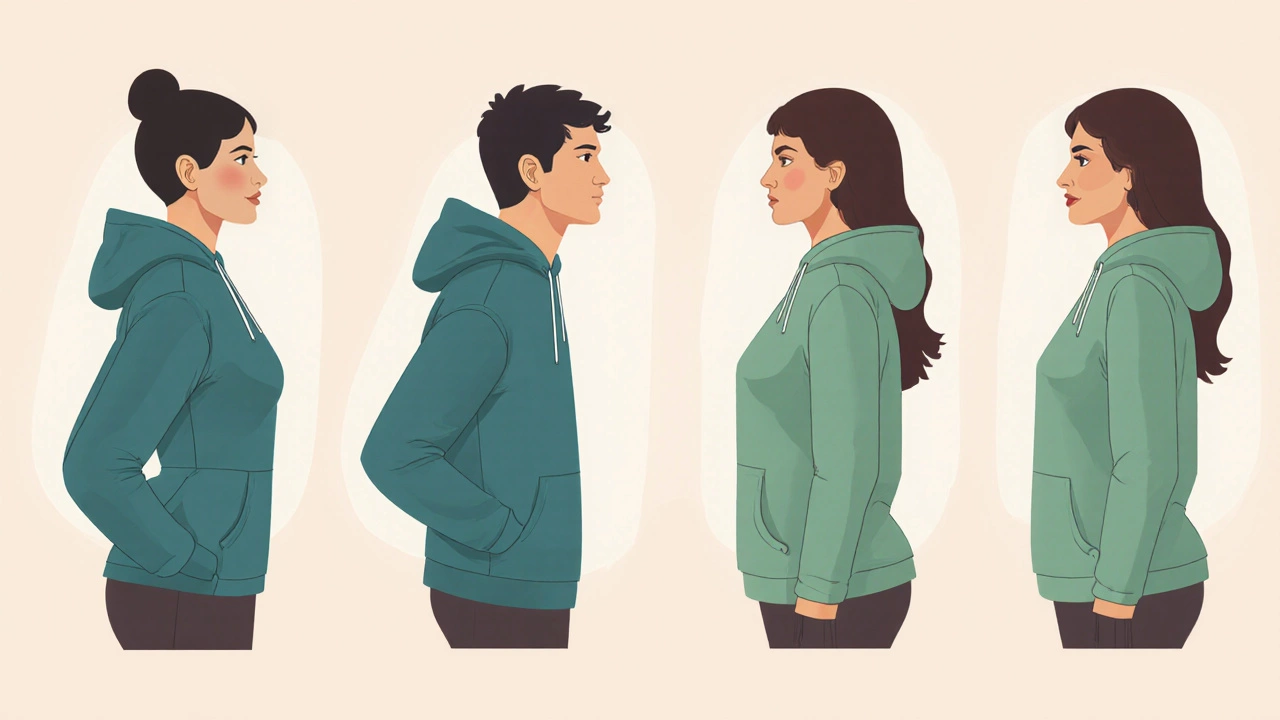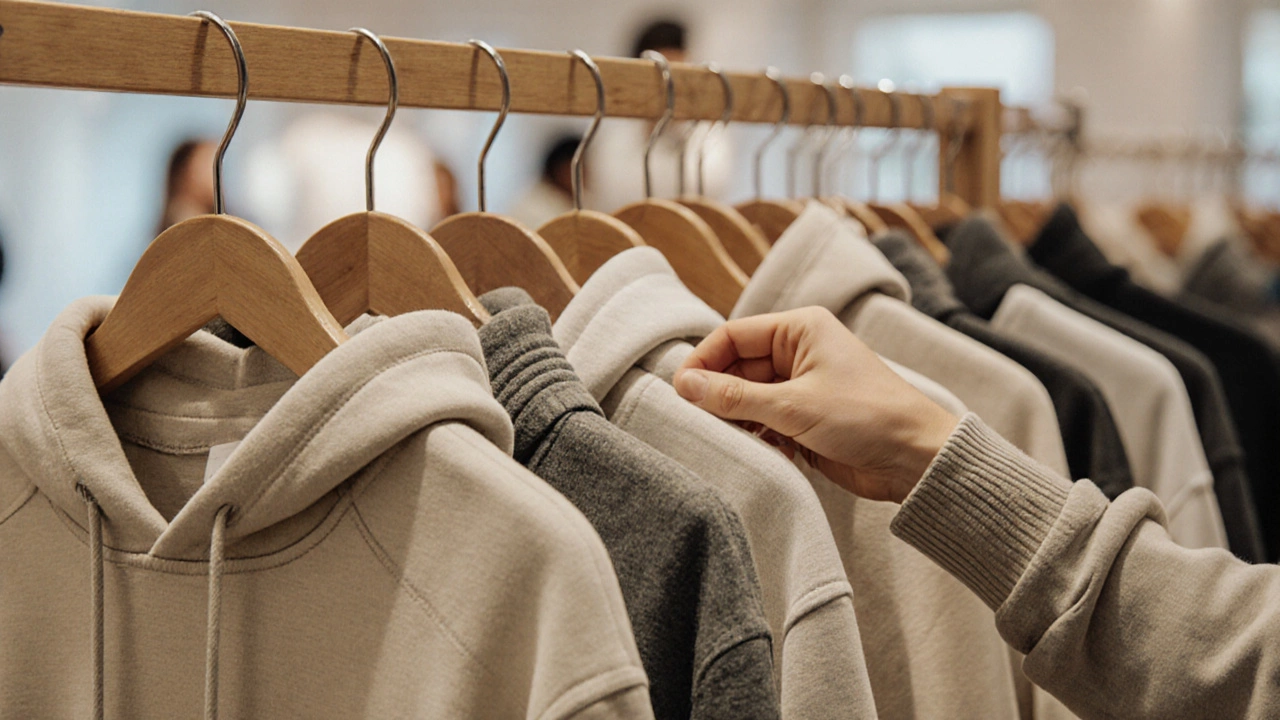Hoodie Fit Assessment Tool
Let's find your perfect hoodie fit
Answer these 5 questions based on your needs and preferences to get personalized recommendations.
1. Activity Level
2. Body Shape
3. Fabric Preference
4. Style Goal
5. Layering Needs
Your Personalized Hoodie Fit Recommendation
When you grab a hoodie off the rack, the first question that pops up is: should it hug my body or drape loosely? The answer isn’t one‑size‑fits‑all. It hinges on the hoodie’s material, your body shape, the look you’re chasing, and how you plan to layer it. Below you’ll find a step‑by‑step guide that lets you decide when a snug silhouette works and when a relaxed cut shines.
Key Takeaways
- Tight hoodies highlight shape and work best with athleisure or street‑style outfits.
- Loose hoodies offer comfort, layer‑friendliness, and a casual vibe.
- Fabric matters: stretchy cotton blends favor tighter fits, while heavyweight fleece feels better relaxed.
- Know your body shape - hourglass, rectangle, or triangle - to pick the most flattering cut.
- Use the quick checklist at the end to size‑check before you buy.
Understanding Hoodie Anatomy
Hoodies are casual, pullover or zip‑up tops featuring a hood, a front pocket, and ribbed cuffs. They originated in sportswear in the 1930s, but today they mingle with streetwear, athleisure, and everyday casual looks. The main components that affect fit are:
- Body (torso) length - shorter cuts look sportier, longer cuts add street cred.
- Sleeve cut - raglan vs set‑in influences mobility.
- Fabric stretch - a blend of cotton and polyester typically offers a bit of give, while 100% fleece is more rigid.
- Hem style - tapered vs straight affects whether the hoodie hugs the hips.
How Fit Changes the Look
A snug hoodie creates a defined silhouette, showing off shoulders, chest, and waist. It pairs well with slim pants, joggers, or high‑waisted jeans for a sleek, athletic vibe. On the flip side, a loose hoodie adds volume, giving off an easy‑going, laid‑back aesthetic that works with baggy cargoes or oversized jeans.
Think of the difference like a pair of jeans: a skinny pair shows shape, while relaxed denim hides it. The same principle applies to hoodies, but the comfort factor plays a bigger role because you often wear them for hours.

When to Choose a Tight Hoodie
- Performance‑oriented activities: If you’re hitting the gym, a tighter fit prevents excess fabric from getting in the way.
- Layer under outerwear: A close‑fitting hoodie slides smoothly beneath a bomber or puffer without adding bulk.
- Body‑positive styling: People with defined waistlines or athletic builds can accentuate their shape.
- Street‑style aesthetics: Tight hoodies sit nicely under graphic tees or long‑sleeve shirts for layered looks.
Look for a stretch‑cotton blend (often labeled 85% cotton / 15% elastane) that offers a little give. Check the shoulder seam - it should land right at the edge of your shoulder, not beyond.
When to Go Loose
- Comfort first: On a chill day you’ll likely be moving around, so unrestricted movement feels better.
- Layering for warmth: Loose hoodies accommodate flannel shirts, turtlenecks, or even a lightweight sweater underneath.
- Casual street look: Pair a baggy hoodie with relaxed joggers or distressed denim for a vibe that screams “I don’t try too hard”.
- Body concealment: If you prefer to downplay hips or stomach, a looser cut drapes over those areas.
Heavyweight fleece (often 100% cotton) works best here because the extra thickness adds warmth, and the looser silhouette prevents the hoodie from looking shapeless.
Body Shape Guide - Which Fit Flatters You?
Below is a quick look at common body silhouettes and the hoodie cut that usually works best.
| Body Shape | Best Fit | Why It Works |
|---|---|---|
| Hourglass | Tight to semi‑tight | Highlights waist and balanced shoulders/hips. |
| Rectangle (athletic) | Relaxed with slight taper | Adds definition to the torso without overwhelming the frame. |
| Triangle (pear) | Loose on the hips, tighter at shoulders | Creates balance by drawing eye upward. |
| Inverted Triangle | Slightly loose overall | Softens broad shoulders, adds volume to lower body. |

Layering & Practical Tips
Layering isn’t just about staying warm; it’s a styling tool. Here’s how you can make both fits work.
- Under a tight hoodie: Wear a thin, moisture‑wicking tee. The hoodie acts like a second‑skin shell.
- Over a loose hoodie: Add a structured bomber or denim jacket. The contrast of silhouettes creates visual interest.
- Seasonal swaps: In spring, ditch the heavy fleece for a lightweight French terry-still loose but less bulky.
- Accessories: A beanie or cap pairs well with both fits; choose a slimmer beanie for tight hoodies, a slouchy beanie for loose ones.
Quick Fit Checklist Before You Buy
- Hold the hoodie up: the seam should line up with the end of your shoulder.
- Slide your arms inside: you should be able to raise them without the fabric pulling.
- Check the chest: there should be ~1‑2 inches of room when you place your hand between chest and fabric.
- Look at the length: the hem should sit at or just below your hips for casual wear; a sportier cut ends at mid‑riff.
- Feel the fabric: stretchy blends feel like a second skin; heavyweight fleece feels thick and cozy.
If you’re between sizes, consider how you’ll layer. A size up works for most loose‑fit needs, while a size down can give that sleek, tight look.
Final Thoughts
There’s no universal rule that says hoodies must be tight or loose. The sweet spot lies in matching the hoodie’s cut to your activity, body shape, and personal style. By paying attention to fabric, silhouette, and layering options, you can own either fit with confidence.
Frequently Asked Questions
Can I wear a tight hoodie for everyday errands?
Absolutely. A tight hoodie paired with slim joggers or straight‑leg jeans offers a sleek, comfortable look that’s perfect for running errands. Just make sure the fabric has some stretch so you stay comfortable all day.
What’s the best hoodie material for a loose, warm fit?
Heavyweight fleece made from 100% cotton or a cotton‑polyester blend (e.g., 80% cotton / 20% polyester) provides bulk and insulation while maintaining a soft drape. Look for “French terry” or “brushed fleece” labels for extra warmth.
How do I know if a hoodie is too tight?
If you can’t comfortably raise your arms, if the chest feels pinched, or if the hoodie pulls at the shoulders when you move, it’s likely too tight. A good rule of thumb is being able to slide a hand flat against your chest under the fabric.
Is a loose hoodie appropriate for the office?
In creative or casual workplaces, a well‑kept, neutral‑colored loose hoodie paired with chinos or smart trousers can work. Stick to a clean silhouette, avoid graphic overload, and layer under a blazer if needed.
Should I size up for a loose hoodie or buy a larger size?
If you already own a hoodie that feels snug, moving up one size usually gives you the desired drop‑shoulder, relaxed look. If you’re buying new, check the brand’s specific size chart and read reviews about their cut.

